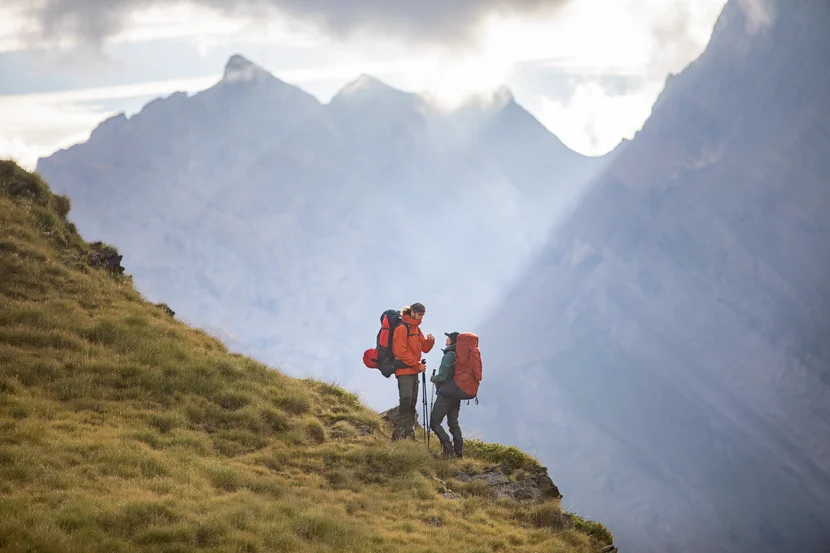
TREKKING BACKPACK ADVICE FROM DEUTER
You are still looking for a suitable trekking backpack? Or you are planning your next tour and still have a few questions about the individual adjustment of the carrying system, the weight or range of use? Then you’ve come to the right place! We try to answer all your questions about trekking backpacks and help you to find a backpack that suits you and your adventure.
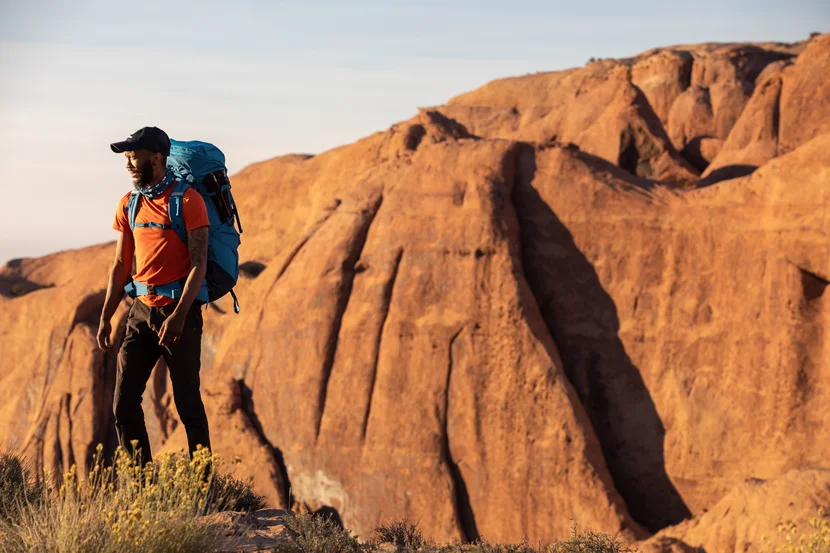
WHICH TREKKING BACKPACK FITS ME?
The volume is not the only decision criterion when choosing the right model. The larger a backpack is, the more important is an individually fitting carrying system. Only with it do the anatomically shaped S-straps nestle neatly around the shoulders and guarantee freedom of movement and wearing comfort. That’s why the back length plays an important role when choosing a backpack.
HOW CAN YOU MEASURE THE BACK LENGTH?
MEASURING POINT 1 CERVICAL VERTEBRA
Tilt head downward. Below the base of the neck, vertebra C7 bulges out.
MEASURING POINT 2 LUMBAR VERTEBRA
A belt can serve as a measuring aid. Place the upper edge of the belt at the level of the upper edges of the hip bones. These are at the level of the lumbar vertebra L3.
Then place a measuring tape at C7 and measure to the upper edge of the belt or upper edge of the hip bones.
You can also measure your back length on your own, follow these instructions.
Once you know your back length, you can check our size chart to see which trekking backpack fits you!
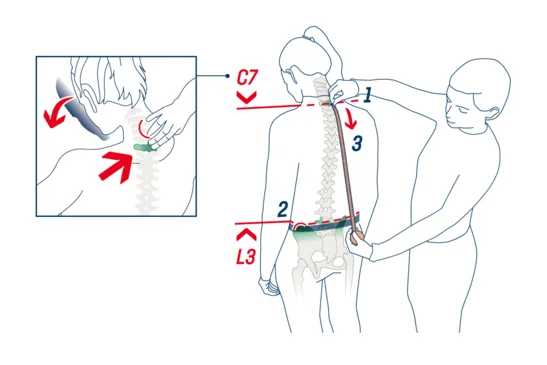
TREKKING AREAS OF USE
Whether for a long-distance hike, hut trekking, pilgrimage or expedition in the wilderness. We have the right trekking backpack for all areas. In order to be able to enjoy the adventure to the fullest, we have, in addition to well thought-out functions, placed particular emphasis on maximum comfort. Thanks to individually adjustable carrying systems, you can easily and comfortably carry even heavy loads over a longer period of time. Click here to see our trekking giants that meet different requirements:
CORRECT USAGE OF A TREKKING BACKPACK
THE NUTS AND BOLTS: ADAPTING THE SUPPORT SYSTEM
Especially with loads over ten kilograms and long walking times, individual adjustment is crucial for carrying comfort. That’s why we equip our models from a volume of 35 liters with a system for back length adjustment. For smaller models, it makes sense to do without a back length adjustment in order to keep the dead weight as low as possible. Here, the backpacks can be adjusted to the back length via the sizes for men, for women (SL) and for tall people (EL). Here we are guided by the proportions of an athletically built average person.
VARISLIDE SYSTEM
Perfect fit in an instant for any back length thanks to stepless VariSlide adjustment:
- Lift the plastic buckle centrally located on the carrying system.
- At the same time, pull or push the carrier heart with the ergonomically cut shoulder straps into the appropriate position.
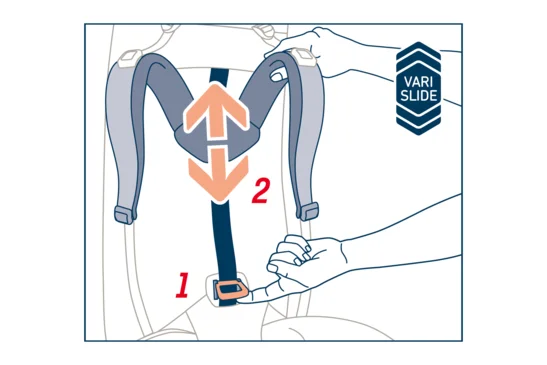
VARIQUICK SYSTEM
For backpacks with VariQuick system, always adjust the back length as follows:
- Open the Velcro strap on the carrier heart and pull it off the backpack.
- Then thread through the matching four attachment loops to the top, tighten and close the Velcro.
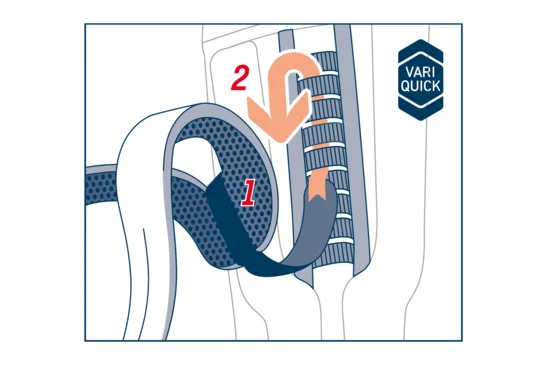
HOOK & LOOP SYSTEM
This system in our ultralight trekking backpack provides individual wearing comfort by adjusting the length of the back. Simply hook carabiner into matching loop.
| Loop | 1 | 2 | 3 |
| Men back length | 44 cm | 46 cm | 48 cm |
| Women (SL) back length | 40 cm | 42 cm | 44 cm |
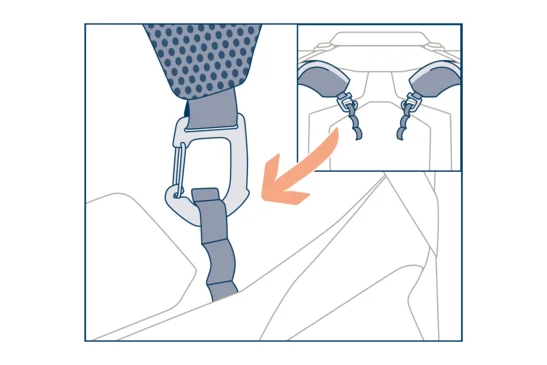
HOW TO PROPERLY PACK YOUR TREKKING BACKPACK
For the perfect wearing comfort, in addition to the right backpack, the right application also plays a decisive role. This includes the correct packing and for models with adjustable back length, the exact adjustment. The most important thing when packing a backpack is to avoid taking anything superfluous in the first place!
The center of gravity of the backpack should be close to the body and preferably at shoulder height. This way, it is always above your own body’s center of gravity and the backpack does not pull backwards when carried.
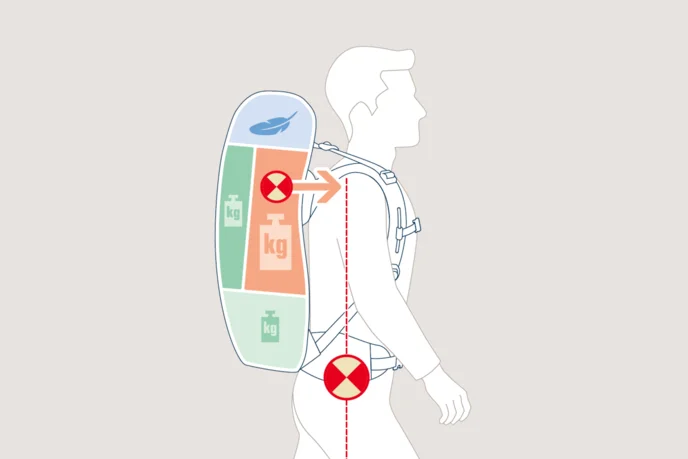
HOW MUCH WEIGHT CAN A TREKKING BACKPACK CARRY?
TREKKING LOAD CLASSES
WHAT DOES THIS CLASSIFICATION MEAN FOR OUR TREKKING BACKPACKS?
Our load classes are not about the maximum load capacity of our trekking backpacks. They can withstand much more than we want them to carry. We understand them as guide values. We are concerned with carrying comfort. This is always a combination of the following factors:
- Construction and stability of the back system
- Expected duration of wearing. Example: trekking backpack versus travel backpack.
- Individual requirements of a product. E.g.: Thru-hikers value a product that is as light as possible for thru-hiking, while the highest level of comfort is required for trekking.
- Individual fitness. Ex: The expectations of an expedition participant are higher than those of a classic recreational hiker.
- Finally, the specifications are also based on the usual and reasonable equipment in use.
Our load classes are intended to provide orientation in the selection of the appropriate trekking backpack. In any case, we recommend that you test a backpack with the appropriate load yourself.
LOAD CLASS 1 |
LOAD CLASS 2 |
LOAD CLASS 3 |
| Stable frame, which in combination with padded hip fins provides very good load transfer
• Touring backpacks, long distance hiking |
Reinforced frame with direct connection to the differently padded hip fins for higher load transfer over long periods of wear
• Trekking, work and travel, longer trips |
Reinforced frame with direct connection of the differentiated padded hip fins for higher load transfer during long periods of wear
• Trekking with food, long trips |
TREKKING PACKING LISTS: WHAT YOU NEED ON YOUR TREKKING TOUR
APPLIES TO EVERY TOUR:
Carry as little as possible – but as much as necessary! Together with the state-certified mountain guides from the Association of German Mountain and Ski Guides, we have compiled our wealth of experience as tips for you in packing lists. Please note that all weights are only recommendations and may vary. In general you can assume: The higher the quality of the equipment, the lighter it is. We wish you a lot of fun “on tour”!
ON HUT TREKKING
INDISPENSABLE |
WEIGHT |
| Trekking backpack 35 – 60 Liter | 1900 g |
| Spare ls and ss shirt | 350 g |
| Water and windproof jacket | 500 g |
| Water and windproof pants | 300 g |
| Functional shorts | 200 g |
| Long underwear | 170 g |
| 3 x pairs of underwear and socks | 250 g |
| Beanie or headband | 60 g |
| Cap or buff | 60 g |
| Thin gloves | 50 g |
| Suncream over LSF 30 & lip balm | 60 g |
| Sunglasses, best self-tinting | 30 g |
| Drinking bottle or streamer with at least 1 liter of liquid (depending on tour) |
1190 g |
| Dried fruit, nuts, bars as needed | 200 g |
| Electrolyte / magnesium tablets | 50 g |
| First aid kit with personal medicines | 310 g |
| Blister plasters, headache tablets | 40 g |
| ID, cash, EC card | 40 g |
| Hut sleeping bag | 250 g |
| Washing bag with hygiene items | 160 g |
| large functional towel | 150 g |
| Headlamp | 80 g |
| Cell phone with emergency numbers | 130 g |
APPROXIMATE TOTAL WEIGHT “INDISPENSABLE” (INCL. BACKPACK) |
6,53 KG |
RECOMMENDED |
|
| Snack as needed | 200 g |
| Pullover / fleece | 400 g |
| Camera and /-bag | 310 g |
| Thin pants | 200 g |
| T-shirt for cottage (cotton) | 170 g |
| Slippers for cottage | 180 g |
| Pocket knife | 100 g |
| Plastic bags (for protective laundry, etc.) | 20 g |
| Spare batteries (headlamp, GPS etc.) | 60 g |
| Telescopic poles | 460 g |
| Via ferrata or high altitude touring equipment (depending on the tour) |
1500 g |
APPROXIMATE TOTAL WEIGHT “RECOMMENDED” |
3,6 KG |
WITHOUT MOUNTAIN GUIDE |
|
| Topographic map | 100 g |
| Tour descriptions | 100 g |
| Altimeter / compass and GPS | 300 g |
| Bivouac sack | 280 g |
APPROXIMATE TOTAL WEIGHT “WITHOUT MOUNTAIN GUIDE” |
0,80 KG |
TOTAL WEIGHT (GUIDELINE) |
10,9 KG |
ON TENT TREKKING
INDISPENSABLE(IN ADDITION TO HUT TREKKING) |
WEIGHT |
| 2 person tent with pegs | 2000 g |
| Sleeping bag (temperature range adapted to the travel time) | 1200 g |
| Camping mat | 800 g |
| Stove with pot | 700 g |
| Stove fuel | 450 g |
| Water filter | 200 g |
| 1 x bagged lunch / day | 125 g |
| Cereals / day | 100 g |
| Tea, coffee, milk powder / day | 25 g |
| Cup / plate / cutlery | 250 g |
| Lighter / igniter | 50 g |
| Folding shovel | 300 g |
| Toilet paper / tissues | 100 g |
APPROXIMATE TOTAL WEIGHT
|
6,4 KG |
TOTAL WEIGHT (GUIDELINE) |
17,3 KG |
